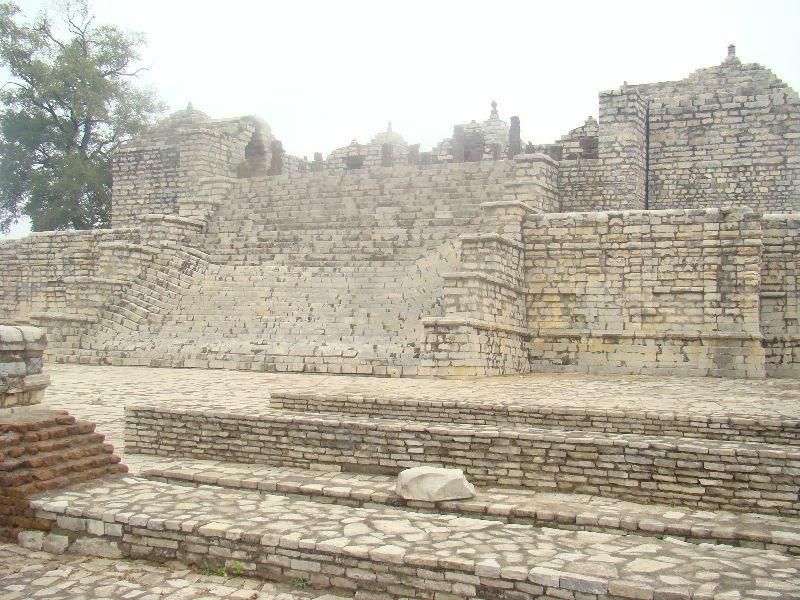Sirpur,
Dakshinkaushal 6th century, on River Mahanadi
Sirpur was much more developed than Harappan Township, reveals
archaeological excavations
Joseph John, TNN Jan 4, 2013, 12.07PM IST

SIRPUR (Chhattisgarh): A nondescript town on the banks of river
Mahanadi in Chhattisgarh, Sirpur, is all set to catapult to international
limelight as the excavations and the rare archaeological findings,
during the last one decade, prove that the region was educationally,
culturally and economically much more developed than the famous
Township of Harappa in the Indus Valley Civilization.
One of the Budha Vihars, an ancient complex found during archaeological
excavations, is being cited as four times bigger than Nalanda,
with unmatched stone carvings - not even seen in Khajuraho. Other
findings such as 22 Shiva temples, four Vishnu temples, 10 Budha
Vihars, and three Jain Vihars, remains of an ancient market, an
Ayurveda treatment centre, underground granary market and a sixth
century 'Ayurvedic Snaan Kund' (an ancient spa), could put Sirpur
in the list of the richest archaeological sites.
Located at a distance of about 90 kms from the state capital,
Sirpur till now was known for the magnificent and ancient east
facing Lakshamana temple built by Vasata, the mother of Mahasivagupta
Balarjuna in 7th century AD, and the Gandeshwar temple, dedicated
to Lord Shiva.
"There are 184 mounds with archaeological remains in an
area spread over 29.25 square kilometres in Sirpur. In the last
11 years, 48 mounds have been exposed through archaeological excavation
and steps have been taken for conservation of the sites,"
said octogenarian archaeologist and excavator AK Sharma, who is
archaeological advisor to the Chhattisgarh government.
The Jains came here first Throwing light on the importance of
the findings during the last one decade, he said the 28 Shiva
temples belonged to Somvanshi period from 6th century to 10th
century while the four Vishnu temples dated back to 5th and 6th
century of Saratpuria era. But the three Jain Vihars of the 4th
century and the findings like the huge statue of Lord Parshvanath
Tirthankar indicate that Jains were the first to come to Sirpur
as traders.
He said the region was a major trade centre during ancient period,
much before it became the capital of Dakshinkaushal in the sixth
century. Sharma said another important archaeological finding
is that of an ancient market complex-considered as the biggest
excavation so far in the world. The findings include materials
from ancient grain market, iron market, metal market and even
remains of ports on the banks of river Mahanadi. This ancient
market was apparently an active trade centre from 6th century
BC to as late as 18th century AD. "Archaeological artifacts
up till the 18th century-such as silver coins of Mughal period
and Tamrapatra of Kalchuri era-were found during excavations,"
he added. "Another important finding is the remains of an
ancient treatment centre, with surgical facilities in Sirpur,
dating back to 7th century.
The unearthed complex, apparently a 10-bed hospital where ancient
surgical instruments were also recovered, is located in front
of a Vishnu Temple and at a most suitable place for a treatment
centre as per Vastu Shastra. Pointing out that moulds for making
gold and silver ornaments, copper plates and stone inscriptions
with dates have been found during excavations, Sharma said objects
discovered during excavations also establish that there was a
well-developed Brahmi script with Sanskrit as a language. Sharma
claimed that Sirpur, which had a highly civilized society engaged
in different trades apart from agriculture, was much more developed.
"Inscriptions found here clearly indicate that people from
different regions used to visit here. It had different forms of
activity, making it richer than the Harappan culture," he
said.
The Boudh Vihar, found during excavations, is magnificent and
it's the biggest temple complex of 6th and 7th centuries to be
covered so far. For the first time, stone carvings depicting sexual
activity among animals have been found-a rarest form of carvings
in Indian Archaeology. "Such carvings are not even seen in
Khajurao and Ellora," he said. Important centre for Buddhist
studies The region was an important centre for Buddhism from 6th
to 10 century where, archaeologists say, more than 10,000 students
used to pursue Buddhist studies. "The buildings were double-storied.
Statues, with features of people from South East Asia, were among
the archaeological artifacts found at Sirpur indicating that even
students from these parts of the world used to visit the region,"
Sharma said. Being an important Buddhist centre, Chinese scholar
and traveller Hiuen Tsang visited Sirpur in the 7th century and
has mentioned the region in his travelogues.
http://articles.timesofindia.indiatimes.com/2013-01-04/india/36148041_1_shiva-temples-sirpur-lord-shiva